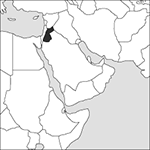
Source: MAPS IN MINUTES™ © RH Publications (1997)
Capital:
Amman
Area:
89,342 sq km (34,495 sq miles)
Population:
6,482,081 (2013 est)
Currency:
1 Jordanian dinar=1000 fils
Religions:
Sunni Muslim 92.0%; Christian 6.0%
Ethnic Groups:
Arab 98.0%; Circassian 1.0%; Armenian 1.0%
Languages:
Arabic (official); English
International Organizations:
UN; Arab League; Non-Aligned Movement; WTO
A mainly inland Middle Eastern country, correctly the Hashemite Kingdom of Jordan, a part of historical Palestine. It borders on Syria in the north, Iraq in the east, Saudi Arabia in the south-east, and Israel in the west.
Physical
Jordan’s natural resources are meagre, and its only outlet to the sea is the port of Aqaba at the north-east end of the Red Sea. Most of the country is on a desert plateau which has only about 250 mm (10 inches) of rain a year; but in the west is the Jordan River valley (whose West Bank is occupied by Israel) where some crops can be grown.
Economy
Jordan lacks natural resources and its economy is dependent on foreign aid. Important exports include clothing, fertilizers, potash, and phosphates. The small agricultural sector produces citrus and other fruit. Jordan’s economic resources have been stretched by large influxes of refugees, most recently from Syria; by the end of 2016 there were around 656,000 Syrian refugees, equivalent to around 10 per cent of the population.
History
The region was part of the Ottoman empire until 1918, when it came under the government of King Faisal in Damascus. In 1920 Transjordan, as it was then called, was made part of the British mandate of Palestine. In 1921 Britain recognized Abdullah ibn Hussein as ruler of the territory and gave him British advisers, a subsidy, and assistance in creating a security force. In 1946 the country was given full independence as the Hashemite Kingdom of Jordan, with Abdullah ibn Hussein as king. In 1948–49 the state was considerably enlarged when Palestinian territories on the West Bank, including the Old City of Jerusalem, were added. As a result of the Six-Day War in 1967, these West Bank territories passed under Israeli occupation. The king was assassinated in 1951, his son Talal was deposed in 1952 as mentally unstable. From 1953 until his death in 1999 Jordan was ruled by Talal’s son, Hussein. He was succeeded by his son, Abdullah II. Palestinian refugees from territory under Israeli occupation established a commando force (fedayeen) in Jordan to raid Israel. Hostility from Palestinian refugees from the West Bank to the moderate policies of Hussein erupted in 1970 between the guerrillas and the government. The mainly Bedouin regiments loyal to the king broke up the military bases of al-Fatah, and the Palestine Liberation Organization moved its forces (1971) to Lebanon and Syria. During the Yom Kippur War Jordan sent tanks to aid Syria, but there was no fighting along the Jordan frontier. In 1974 Jordan’s relations with other Arab countries improved when it accepted that ‘the PLO is the sole and legitimate representative of the Palestinian people’. It supported Iraq in the Iran–Iraq War and suffered severely during the Gulf War from the effects of UN sanctions against Iraq and the arrival of many thousands of expatriates from the Gulf. In June 1991 the 34-year ban on political parties was lifted. In 1993 the first multiparty election since 1956 was held, in which candidates loyal to the king were victorious. Despite the signing of the Israeli–PLO peace accord (1993), Jordan continued its own negotiations with Israel. In 1994 the two countries signed a declaration formally ending the state of conflict between them and agreed a peace treaty. In the early 21st century cautious political reform continued, particularly in 2011 following protests inspired by the Arab Spring. At the same time Jordan has maintained a firm stance against militant Islamists. In June 2018, the King forced his Prime Minister, Hani Mulki, to resign and replaced him with a former World Bank official, Omar al-Razzaz, whom he charged to review the tax system.
- base font
- base(for representation of numbers)
- Basel Agreement
- baselap
- base level
- base level((of a pulse))
- Basel II
- base limiter
- base-limit register
- baseline
- baseline risk
- Basel problem
- basement
- basement membrane
- base metal
- base money
- base(of an exponential function)
- base(of an isosceles triangle)
- base(of a pyramid)
- base(of a triangle)
- base(of logarithms)
- base(of natural logarithms)
- base pairing
- base period
- base rate